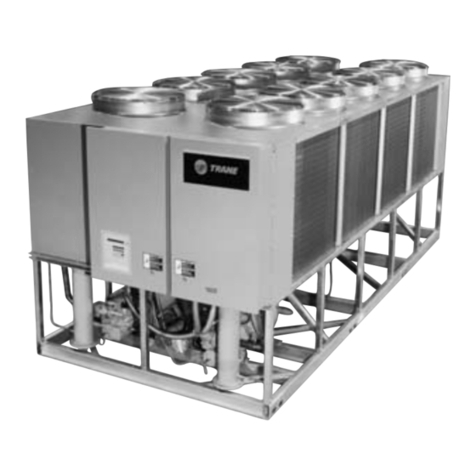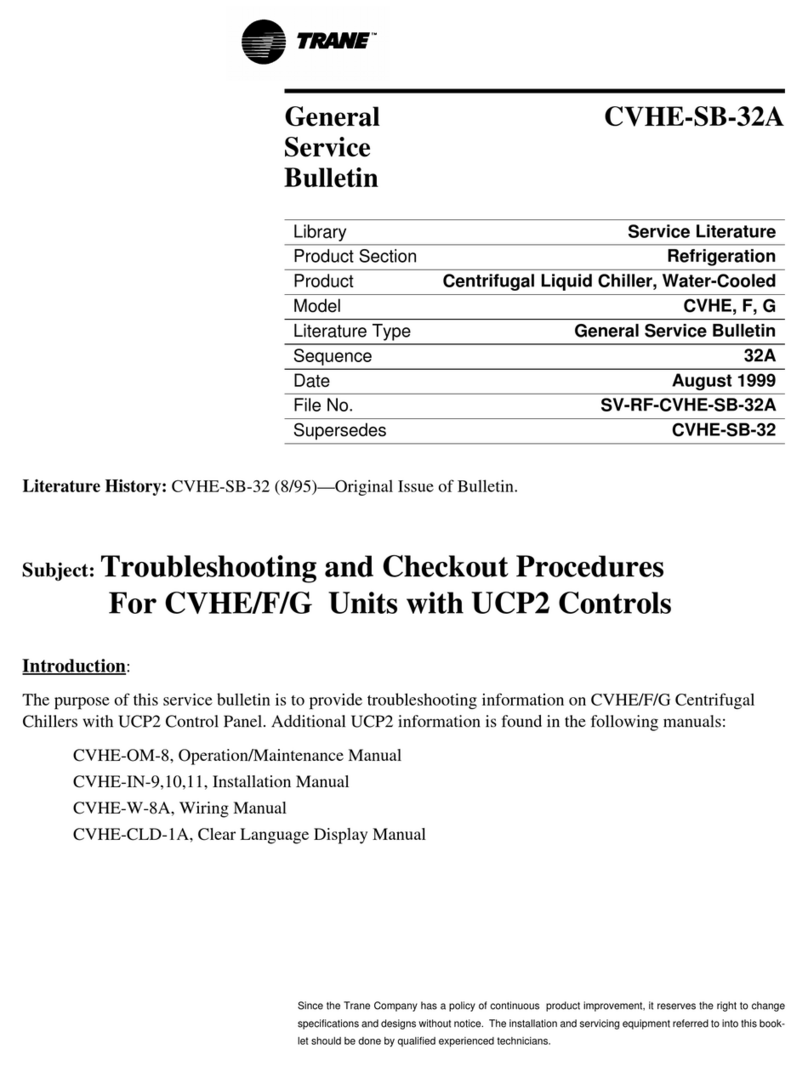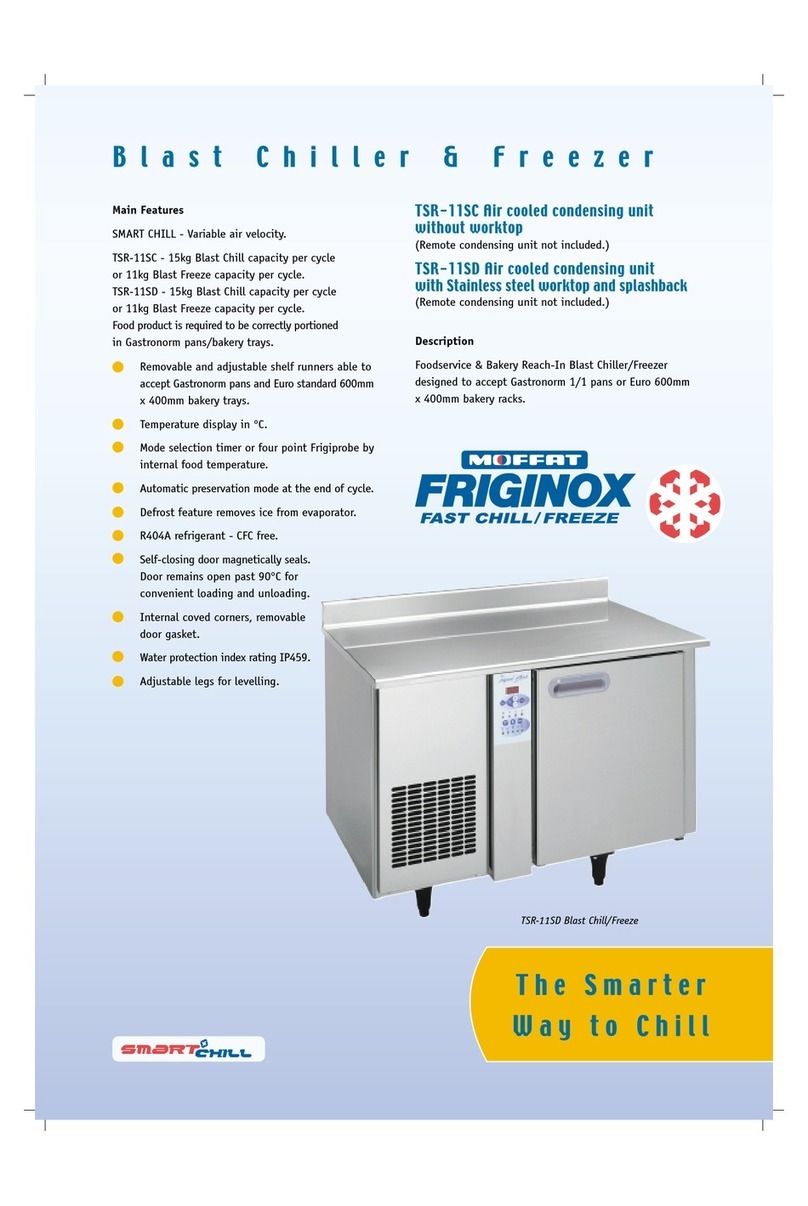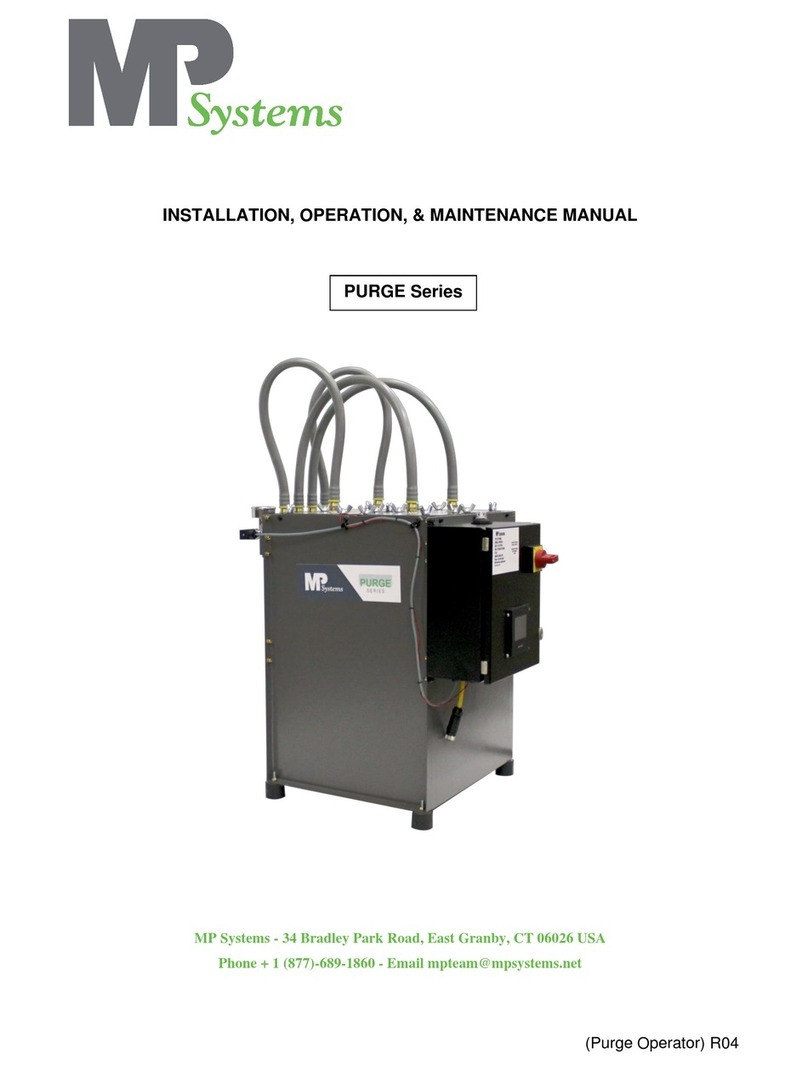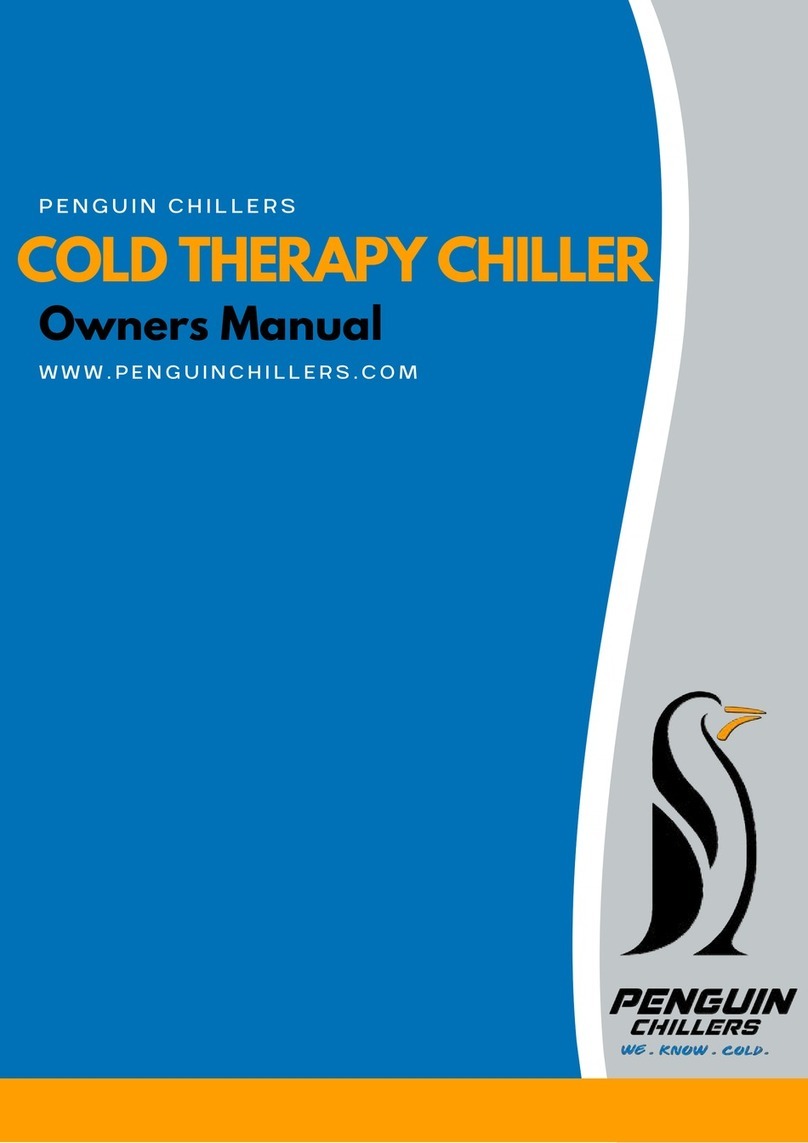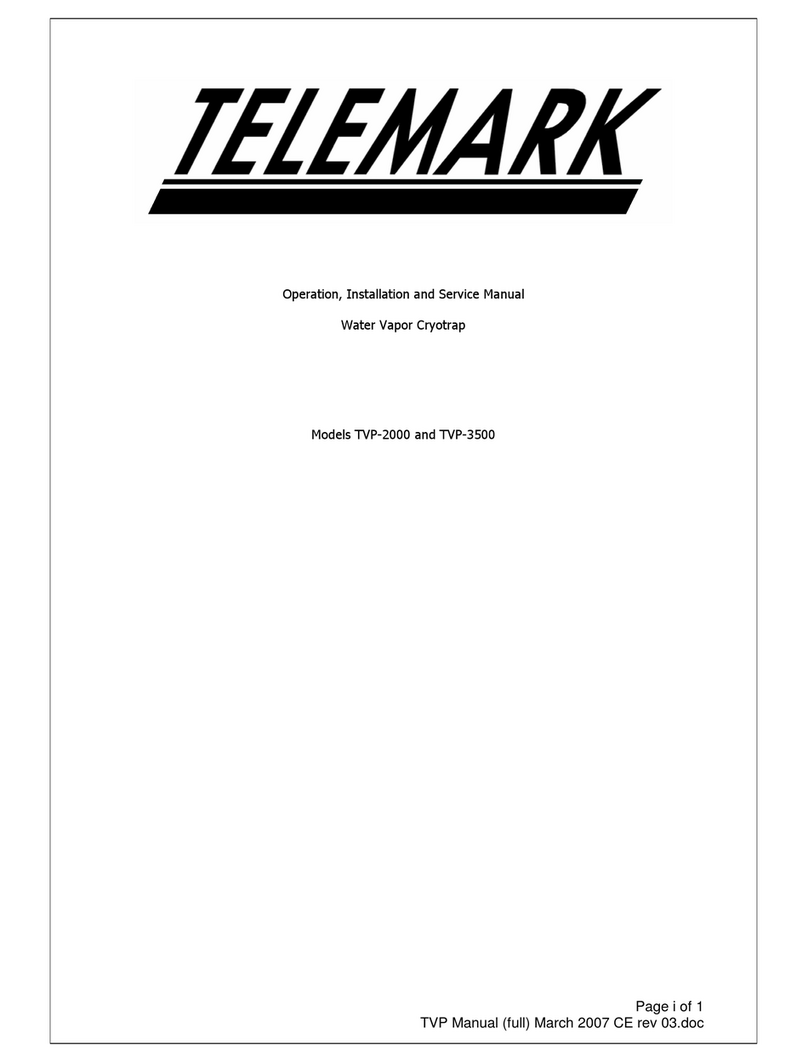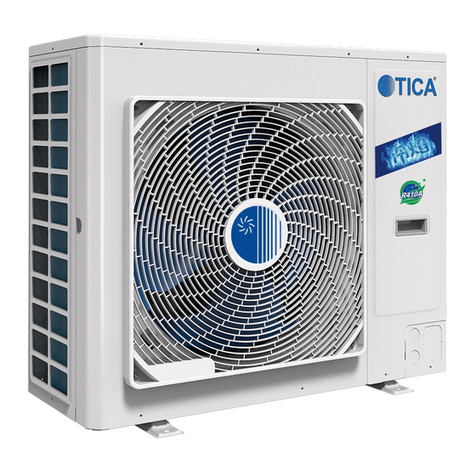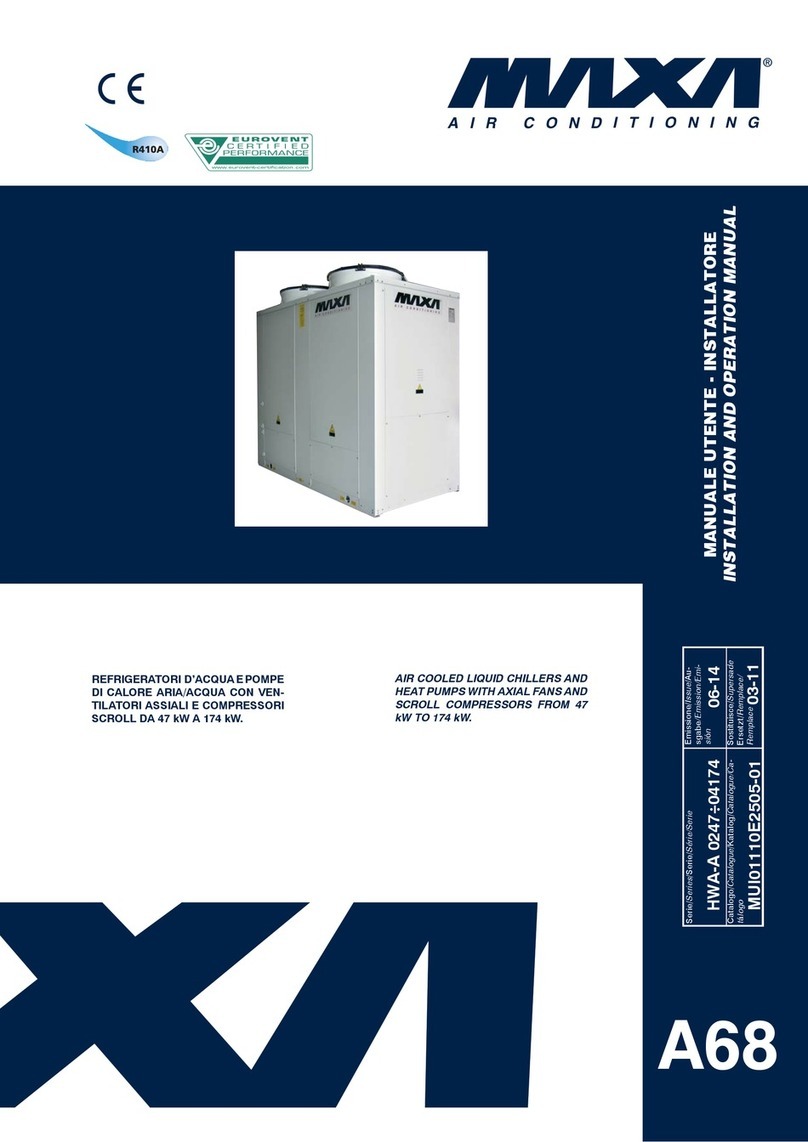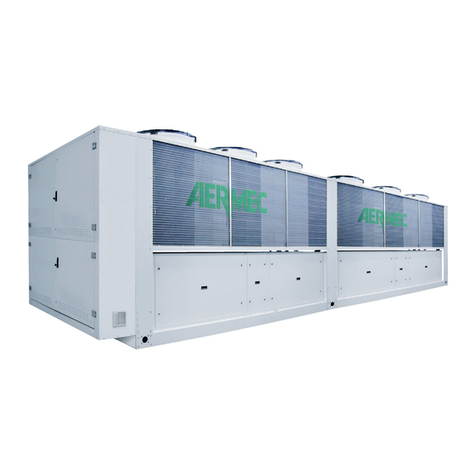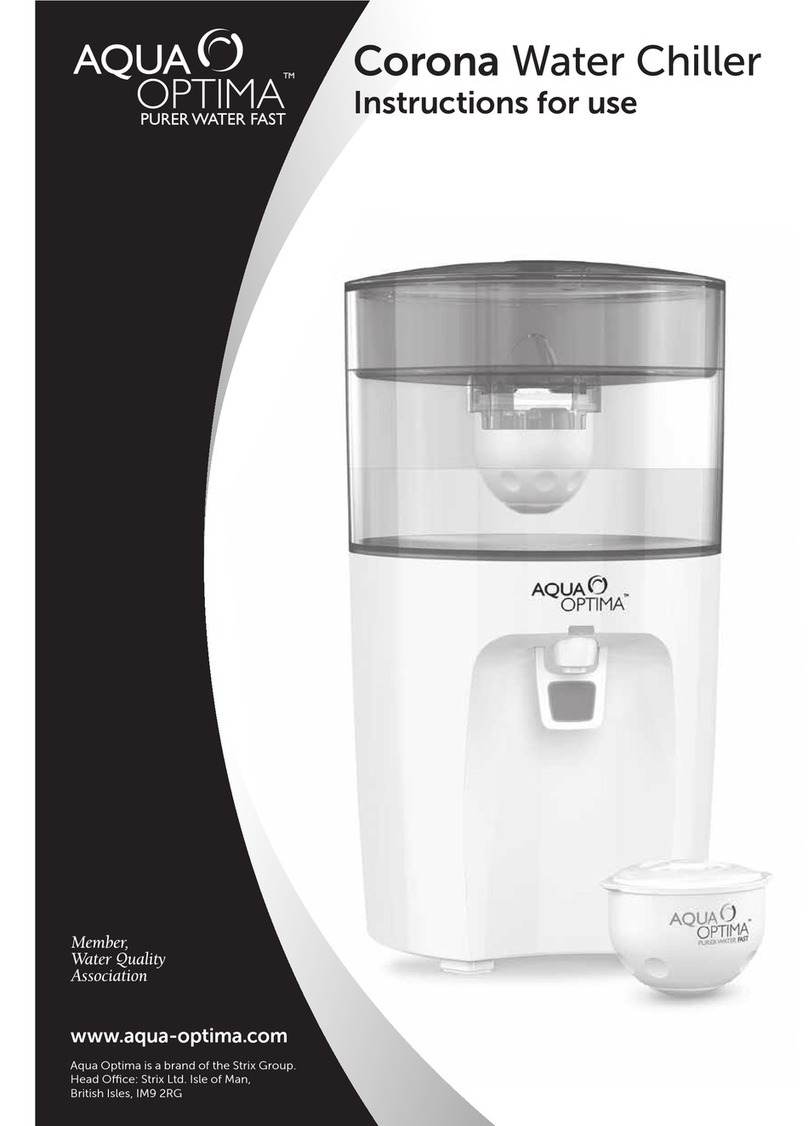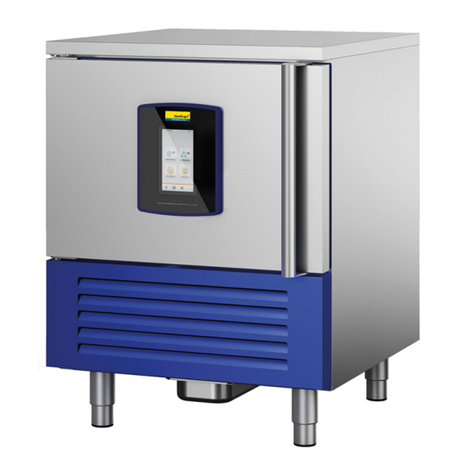Sterlco AquaSnap 30RA010-055 Operation manual

Manufacturer reserves the right to discontinue, or change at any time, specifications or designs without notice and without incurring obligations.
PC 903 Catalog No. 533-00047 Printed in U.S.A. Form 30RA-2T Pg 1 1-03 Replaces: 30RA-1T
Book 2
Ta b 5 c
Controls, Start-Up, Operation,
Service, and Troubleshooting
SAFETY CONSIDERATIONS
Installing, starting up, and servicing this equipment can be
hazardous due to system pressures, electrical components, and
equipment location (roof, elevated structures, mechanical
rooms, etc.). Only trained, qualified installers and service
mechanics should install, start up, and service this equipment.
When working on this equipment, observe precautions in
the literature, and on tags, stickers, and labels attached to the
equipment, and any other safety precautions that apply. Follow
all safety codes. Wear safety glasses and work gloves. Use
care in handling, rigging, and setting this equipment, and in
handling all electrical components.
Electrical shock can cause personal injury and death. Shut
off all power to this equipment during installation and
service. There may be more than one disconnect switch.
Tag all disconnect locations to alert others not to restore
power until work is completed.
DO NOT VENT refrigerant relief valves within a building.
Outlet from relief valves must be vented outdoors in
accordance with the latest edition of ANSI/ASHRAE
(American National Standards Institute/American Society
of Heating, Refrigeration and Air Conditioning Engineers)
15 (Safety Code for Mechanical Refrigeration). The
accumulation of refrigerant in an enclosed space can
displace oxygen and cause asphyxiation. Provide adequate
ventilation in enclosed or low overhead areas. Inhalation of
high concentrations of vapor is harmful and may cause
heart irregularities, unconsciousness or death. Misuse can
be fatal. Vapor is heavier than air and reduces the amount
of oxygen available for breathing. Product causes eye and
skin irritation. Decomposition products are hazardous.
DO NOT attempt to unbraze factory joints when servicing
this equipment. Compressor oil is flammable and there is
no way to detect how much oil may be in any of the
refrigerant lines. Cut lines with a tubing cutter as required
when performing service. Use a pan to catch any oil that
may come out of the lines and as a gage for how much oil
to add to system. DO NOT re-use compressor oil.
This unit uses a microprocessor-based electronic control
system. Do not use jumpers or other tools to short out
components, or to bypass or otherwise depart from recom-
mended procedures. Any short-to-ground of the control
board or accompanying wiring may destroy the electronic
modules or electrical components.
To prevent potential damage to heat exchanger, always run
fluid through heat exchanger when adding or removing
refrigerant charge. Use appropriate brine solutions in cooler
fluid loop to prevent the freezing of brazed plate heat
exchanger, optional hydronic section and/or interconnecting
piping when the equipment is exposed to temperatures
below 32 F (0 °C). Proof of flow switch and strainer are
factory installed on all models. Do NOT remove power
from this chiller during winter shutdown periods without
taking precaution to remove all water from heat exchanger
and optional hydronic system. Failure to properly protect
the system from freezing may constitute abuse and may
void warranty.
Compressors and optional hydronic system pumps require
specific rotation. Test condenser fan(s) first to ensure
proper phasing. Swap any two incoming power leads to
correct condenser fan rotation before starting any other
motors.
Refrigerant charge must be removed slowly to prevent loss
of compressor oil that could result in compressor failure.
30RA010-055
AquaSnap® Air-Cooled Chillers
with ComfortLink™ Controls
50/60 Hz

2
CONTENTS
Page
SAFETY CONSIDERATIONS. . . . . . . . . . . . . . . . . . . . . . . . . 1
GENERAL. . . . . . . . . . . . . . . . . . . . . . . . . . . . . . . . . . . . . . . . . .2,3
MAJOR SYSTEM COMPONENTS. . . . . . . . . . . . . . . . . . .3,4
General . . . . . . . . . . . . . . . . . . . . . . . . . . . . . . . . . . . . . . . . . . . . . 3
Main Base Board (MBB). . . . . . . . . . . . . . . . . . . . . . . . . . . . . 3
Scrolling Marquee Display . . . . . . . . . . . . . . . . . . . . . . . . . . 3
Energy Management Module (EMM). . . . . . . . . . . . . . . . . 3
Enable/Off/Remote Contact Switch. . . . . . . . . . . . . . . . . . 3
Emergency On/Off Switch. . . . . . . . . . . . . . . . . . . . . . . . . . . 3
Board Addresses . . . . . . . . . . . . . . . . . . . . . . . . . . . . . . . . . . . 3
Control Module Communication . . . . . . . . . . . . . . . . . . . . 3
Sterlco ComfortNetwork Interface . . . . . . . . . .. . . . . . . . 3
OPERATING DATA . . . . . . . . . . . . . . . . . . . . . . . . . . . . . . . 4-46
Sensors. . . . . . . . . . . . . . . . . . . . . . . . . . . . . . . . . . . . . . . . . . . . . 4
• T1 — COOLER LEAVING FLUID SENSOR
• T2 — COOLER ENTERING FLUID SENSOR
• T7,T8 — COMPRESSOR RETURN GAS
TEMPERATURE SENSOR (ACCESSORY)
• T9 — OUTDOOR-AIR TEMPERATURE SENSOR
• T10 — REMOTE SPACE TEMPERATURE SENSOR OR
DUAL LEAVING WATER TEMPERATURE SENSOR
Energy Management Module . . . . . . . . . . . . . . . . . . . . . . . 17
Loss-of-Cooler Flow Protection . . . . . . . . . . . . . . . . . . . . 17
Thermostatic Expansion Valves (TXV) . . . . . . . . . . . . . 17
Capacity Control . . . . . . . . . . . . . . . . . . . . . . . . . . . . . . . . . . . 17
• MINUTES LEFT FOR START
• MINUTES OFF TIME
• LEAD/LAG DETERMINATION
• CAPACITY CONTROL OVERRIDES
Head Pressure Control. . . . . . . . . . . . . . . . . . . . . . . . . . . . . 21
Operation of Machine Based on Control Method
and Cooling Set Point Selection Settings . . . . . . . . 22
Cooling Set Point Select . . . . . . . . . . . . . . . . . . . . . . . . . . . 22
Marquee Display Usage . . . . . . . . . . . . . . . . . . . . . . . . . . . . 23
Service Test. . . . . . . . . . . . . . . . . . . . . . . . . . . . . . . . . . . . . . . . 23
Optional Factory-Installed Hydronic Package . . . . . . 24
Cooler Pump Control . . . . . . . . . . . . . . . . . . . . . . . . . . . . . . 24
Cooler Pump Sequence of Operation . . . . . . . . . . . . . . 24
Configuring and Operating Dual Chiller Control. . . . 26
Temperature Reset . . . . . . . . . . . . . . . . . . . . . . . . . . . . . . . . . 43
Demand Limit . . . . . . . . . . . . . . . . . . . . . . . . . . . . . . . . . . . . . . 44
• DEMAND LIMIT (2-Stage Switch Controlled)
• EXTERNALLY POWERED DEMAND LIMIT
(4 to 20 mA Controlled)
•DEMAND LIMIT (SCN Loadshed Controlled)
Cooling Set Point (4 to 20 mA) . . . . . . . . . . . . . . . . . . . . . 45
TROUBLESHOOTING . . . . . . . . . . . . . . . . . . . . . . . . . . . 46-57
Complete Unit Stoppage and Restart . . . . . . . . . . . . . . 46
• GENERAL POWER FAILURE
• UNIT ENABLE-OFF-REMOTE CONTACT SWITCH IS
OFF
• CHILLED FLUID PROOF-OF-FLOW SWITCH OPEN
• OPEN HIGH-PRESSURE SWITCH(ES)
• OPEN COMPRESSOR INTERNAL THERMAL
PROTECTION
• OPEN 24-V CONTROL CIRCUIT BREAKERS
• COOLING LOAD SATISFIED
• THERMISTOR FAILURE
• LOW SATURATED SUCTION
Alarms and Alerts. . . . . . . . . . . . . . . . . . . . . . . . . . . . . . . . . . 53
SERVICE . . . . . . . . . . . . . . . . . . . . . . . . . . . . . . . . . . . . . . . . 58-73
Electronic Components . . . . . . . . . . . . . . . . . . . . . . . . . . . . 58
• CONTROL COMPONENTS
Compressor Replacement . . . . . . . . . . . . . . . . . . . . . . . . . 58
Cooler . . . . . . . . . . . . . . . . . . . . . . . . . . . . . . . . . . . . . . . . . . . . . 58
• BRAZED-PLATE COOLER HEAT EXCHANGER
REPLACEMENT
• BRAZED-PLATE COOLER HEAT EXCHANGER
CLEANING
Check Oil Charge . . . . . . . . . . . . . . . . . . . . . . . . . . . . . . . . . . 60
Page
Condenser Section and Coils . . . . . . . . . . . . . . . . . . . . . . 60
• COIL CLEANING
• CLEANING E-COATED COILS
• CONDENSER SECTION
Check Refrigerant Feed Components . . . . . . . . . . . . . . 61
• THERMOSTATIC EXPANSION VALVE (TXV)
•FILTERDRIER
• MOISTURE-LIQUID INDICATOR
• MINIMUM LOAD VALVE
• PRESSURE RELIEF DEVICES
Compressor and Unit Protective Devices . . . . . . . . . . 62
• MANUAL STARTER
• COMPRESSOR INTERNAL THERMAL PROTECTION
Check Unit Safeties . . . . . . . . . . . . . . . . . . . . . . . . . . . . . . . . 62
• HIGH-PRESSURE SWITCH
• PRESSURE TRANSDUCERS
• COOLER FREEZE-UP PROTECTION
• HEATER CABLE
• WINTER SHUTDOWN
Thermistors. . . . . . . . . . . . . . . . . . . . . . . . . . . . . . . . . . . . . . . . 63
Pressure Transducers . . . . . . . . . . . . . . . . . . . . . . . . . . . . . 63
Flow Sensor . . . . . . . . . . . . . . . . . . . . . . . . . . . . . . . . . . . . . . . 63
Strainer . . . . . . . . . . . . . . . . . . . . . . . . . . . . . . . . . . . . . . . . . . . . 68
Motormaster® V Controller . . . . . . . . . . . . . . . . . . . . . . . . 68
• GENERAL OPERATION
• SET POINTS
•INSTALLATION
• PROGRAMMING
•EPMCHIP
• LIQUID LINE PRESSURE SET POINT ADJUSTMENT
•LOSS OF SCN COMMUNICATIONS
• REPLACING DEFECTIVE MODULES
Hydronic Package . . . . . . . . . . . . . . . . . . . . . . . . . . . . . . . . . 73
MAINTENANCE . . . . . . . . . . . . . . . . . . . . . . . . . . . . . . . . . . . . 74
Recommended Maintenance Schedule . . . . . . . . . . . . 74
PRE-START-UP . . . . . . . . . . . . . . . . . . . . . . . . . . . . . . . . . . . . 74
System Check . . . . . . . . . . . . . . . . . . . . . . . . . . . . . . . . . . . . . 74
START-UP AND OPERATION . . . . . . . . . . . . . . . . . . . . .74-76
Actual Start-Up . . . . . . . . . . . . . . . . . . . . . . . . . . . . . . . . . . . . 74
Check Refrigerant Charge . . . . . . . . . . . . . . . . . . . . . . . . . 75
Operating Limitations. . . . . . . . . . . . . . . . . . . . . . . . . . . . . . 75
• TEMPERATURES
• LOW AMBIENT OPERATION
• VOLTAGE — ALL UNITS
OPERATION SEQUENCE. . . . . . . . . . . . . . . . . . . . . . . . . . . 76
APPENDIX A — SCN TABLES. . . . . . . . . . . . . . . . . . . .77-88
APPENDIX B — FACTORY SETTINGS FOR
COMPRESSOR, FAN, PUMP AND MANUAL
STARTERS . . . . . . . . . . . . . . . . . . . . . . . . . . . . . . . . . . . .89,90
APPENDIX C — BUILDING INTERFACE . . . . . . . . . .91,92
START-UP CHECKLIST FOR 30RA LIQUID
CHILLER. . . . . . . . . . . . . . . . . . . . . . . . . . . . . . . .CL-1-CL-8
GENERAL
This publication contains Controls Start-Up, Service, Oper-
ation, and Troubleshooting information for the 30RA
AquaSnap® air-cooled chillers. See Table 1. These chillers are
equipped with ComfortLink™controls and conventional
thermostatic expansion valves (TXVs).
This unit uses a microprocessor-based electronic control
system. Do not use jumpers or other tools to short out or
bypass components or otherwise depart from recom-
mended procedures. Any short-to-ground of the control
board or accompanying wiring may destroy the board or
electrical component.

3
Table 1 — Unit Sizes
*60 Hz only.
†50 Hz only.
MAJOR SYSTEM COMPONENTS
General — The 30RA air-cooled reciprocating chillers
contain the ComfortLink™ electronic control system that
controls and monitors all operations of the chiller.
The control system is composed of several components as
listed in the sections below. See Fig. 1 and 2 for typical control
box drawing. See Fig. 3-6 for control schematics.
Main Base Board (MBB) — See Fig. 7. The MBB is
the heart of the ComfortLink control system. It contains the
major portion of operating software and controls the operation
of the machine. The MBB continuously monitors input/output
channel information received from its inputs and from all other
modules. The MBB receives inputs from the discharge and
suction pressure transducers and thermistors. See Table 2. The
MBB also receives the feedback inputs from each compressor
contactor, auxiliary contacts, and other status switches. See
Table 3. The MBB also controls several outputs. Relay outputs
controlled by the MBB are shown in Table 4. Information
is transmitted between modules via a 3-wire communication
bus or LEN(Local Equipment Network). The SCN (Sterlco
Comfort Network) bus is also supported. Connections to both
LEN and SCN busesare made atTB3. See Fig. 8.
Scrolling Marquee Display — This standard device
is the keypad interface used for accessing chiller information,
reading sensor values, and testing the chiller. The marquee
display is a 4-key, 4-character, 16-segment LED (light-emitting
diode) display. Eleven mode LEDs are located on the display
as well as an Alarm Status LED. See Marquee Display Usage
section on page 23 for further details.
Energy Management Module (EMM) — The EMM
module is available as a factory-installed option or as a field-
installed accessory. The EMM module receives 4 to 20 mA
inputs for the leaving fluid temperature reset, cooling set point
and demand limit functions. The EMM module also receives
the switch inputs for the field-installed 2-stage demand limit
and ice done functions. The EMM module communicates the
status of all inputs with the MBB, and the MBB adjusts the
control point, capacity limit, and other functions according to
the inputs received.
Enable/Off/Remote Contact Switch — The Enable/
Off/Remote Contact switch is a 3-position switch used to
control the chiller. When switched to the Enable position the
chiller is under its own control. Move the switch to the Off
position to shut the chiller down. Move the switch to the
Remote Contact position and a field-installed dry contact can
be used to start the chiller. The contacts must be capable of
handling a 24 vac, 50-mA load. In the Enable and Remote
Contact (dry contacts closed) positions, the chiller is allowed to
operateand respond to the scheduling configuration, SCN
configuration and set point data. See Fig. 8.
Emergency On/Off Switch — The Emergency On/Off
switch should only be used when it is required to shut the
chiller off immediately. Power to the MBB, EMM, and
marquee display is interrupted when this switch is off and all
outputs from these modules will be turned off.
Board Addresses — The Main Base Board (MBB) has
a 3-position Instance jumper that must be set to ‘1.’ All other
boards have 4-position DIP switches. All switches are set to
‘On’ for all boards.
Control Module Communication
RED LED — Proper operation of the control boards can be
visually checked by looking at the red status LEDs
(light-emitting diodes). When operating correctly, the red status
LEDs should be blinking in unison at a rate of once every
2 seconds. If the red LEDs are not blinking in unison, verify
that correct power is being supplied to all modules. Be sure that
the Main Base Board (MBB) is supplied with the current
software. If necessary, reload current software. If the problem
still persists, replace the MBB. A red LED that is lit continu-
ously or blinking at a rate of once per second or faster indicates
that the board should be replaced.
GREEN LED — The MBB has one green LED. The Local
Equipment Network (LEN) LED should always be blinking
whenever power is on. All other boards have a LEN LED
which should be blinking whenever power is on. Check LEN
connections for potential communication errors at the board J3
and/or J4 connectors. Communication between modules is
accomplished by a 3-wire sensor bus. These 3 wires run in
parallel from module to module. The J4 connector on the MBB
provides both power and communication directly to the
marquee display only.
YELLOW LED — The MBB has one yellow LED. The
Sterlco Comfort Network (SCN) LEDwillblink during times
of network communication.
Sterlco Comfort Network (SCN) Interface —
The 30RA chiller unitscan be connectedtotheSCN if
desired. The communication bus wiring is a shielded,
3-conductor cable with drain wire and is supplied and installed
in the field. See Table 5. The system elements are connected to
the communication bus in a daisy chain arrangement. The
positive pin of each system element communication connector
must be wired to the positive pins of the system elements on
either side of it. This is also required for the negative and
signal ground pins of each system element. Wiring connections
for SCN should be made at TB3. Consultthe SCN Contrac-
tor’s Manual for further information.
NOTE: Conductors and drain wire must be 20 AWG (Ameri-
can Wire Gage) minimum stranded, tinned copper. Individual
conductors must be insulated with PVC, PVC/nylon, vinyl,
Teflon, or polyethylene. An aluminum/polyester 100% foil
shield and an outer jacket of PVC, PVC/nylon, chrome vinyl,
or Teflon with a minimum operating temperature range of
–20 C to 60 C is required. Wire manufactured by Alpha (2413
or 5463), American (A22503), Belden (8772), or Columbia
(02525) meets the above mentioned requirements.
It isimportant when connecting toa SCN communication
bus that a color coding scheme be used for the entire network
to simplify the installation. It is recommended that red be used
for the signal positive, black for the signal negative, and white
for the signal ground. Use a similar scheme for cables contain-
ing different colored wires.
UNIT NOMINAL CAPACITY
(TONS) 50/60 Hz
30RA010 10/10
30RA015 14/13
30RA018 16/16
30RA022 22/20
30RA025 24/23
30RA030* 27
30RA032† 30
30RA035 35/34
30RA040* 38
30RA042† 40
30RA045 43/45
30RA050* 47
30RA055* 54

4
At each system element, the shields of its communication
bus cables must be tied together. If the communication bus is
entirely within one building, the resulting continuous shield
must be connected to a ground at one point only. If the commu-
nication bus cable exits from one building and enters another,
the shields must be connected to grounds at the lightning
suppressor in each building where the cable enters or exits the
building (one point per building only). To connect the unit to
the network:
1. Turn off power to the control box.
2. Cut the SCNwire and strip the ends of the red (+), white
(ground), and black (–) conductors. (Substitute appropri-
ate colors for different colored cables.)
3. Connect the red wire to (+) terminal on TB3 of the plug,
the white wire to COM terminal, and the black wire to the
(–) terminal.
4. The RJ14 SCN connector on TB3 can also be used, but is
only intended for temporary connection (for example, a
laptop computer running Service Tool).
Table 2 — Thermistor Designations
LEGEND
Table 3 — Status Switches
Table 4 — Output Relays
Table 5— SCN Communication BusWiring
OPERATING DATA
Sensors — The electronic control uses 3 to 6 thermistors to
sense temperatures for controlling chiller operation. See
Table 2. These sensors are outlined below. Thermistors T1, T2,
T9 and accessory suction gas temperatures (T7,T8) are 5 kΩ at
77 F (25 C) and are identical in temperature versus resistance
and voltage drop performance. Thermistor T10 is 10 kΩ at
77 F (25 C) and has a different temperature vs. resistance and
voltage drop performance. See Thermistors section for
temperature-resistance-voltage drop characteristics.
T1 — COOLER LEAVING FLUID SENSOR— On 30RA010-
030 sizes, this thermistor is installed in a friction fit well at the
bottom of the brazed-plate heat exchanger on the control box
side. For 30RA032-055 sizes, this thermistor is installed in a
well in the factory-installed leaving fluid piping coming from
the bottom of the brazed-plate heat exchanger opposite the
control box side.
T2—COOLERENTERINGFLUIDSENSOR—On 30RA010-
030 sizes, this thermistor is installed in a friction fit well at the
top of the brazed-plate heat exchanger on the control box side.
For 30RA032-055 sizes, this thermistor is installed in a well in
the factory-installed entering fluid piping coming from the top
of the brazed-plate heat exchanger opposite the control box
side.
T7,T8 — COMPRESSOR RETURN GAS TEMPERA-
TURE SENSOR (ACCESSORY) — A well for this sensor
is factory installed in each circuit's suction line. If desired, a
5 kΩthermistor (Sterling partnumber HH79NZ029) can be
installed in this well and connected to the Main Base Board
as shown in Table 2. Use the Scrolling Marquee display to con-
figure the sensor (Configuration mode, sub-mode OPT1 —
enable item RG.EN).
T9 — OUTDOOR-AIR TEMPERATURE SENSOR —
This sensor is factory-installed on a bracket at the left side of
compressor A1 on 30RA010-030 models. For models
30RA032-055, it is installed behind the panel below the
control box center door.
IMPORTANT: A shorted SCN buscable will prevent some
routines from running and may prevent the unit from start-
ing. If abnormal conditions occur, unplug the connector. If
conditions return tonormal, checkthe SCNconnector and
cable. Run new cable if necessary. A short in one section of
the bus can cause problems with all system elements on the
bus.
THERMISTOR
NO.
PIN
CONNECTION
POINT
THERMISTOR INPUT
T1 J8-13,14 (MBB) Cooler Leaving Fluid
T2 J8-11,12 (MBB) Cooler Entering Fluid
T7 J8-1,2 (MBB) Circuit A Return Gas
Temperature (Accessory)
T8 J8-3,4 (MBB) Circuit B (032-055 only) Return
Gas Temperature (Accessory)
T9 J8-7,8 (MBB) Outdoor-Air Temperature
Sensor
T10
J8-5,6 (MBB)
TB5-5,6
Accessory Remote Space
Temperature Sensor or
Dual LWT Sensor
LWT — Leaving Water Temperature
MBB — Main Base Board
STATUS
SWITCH
PIN CONNECTION
POINT
Chilled Water Pump 1 J7-1,2
Chilled Water Pump 2 J7-3,4
Remote On/Off TB5-9,10
Cooler Flow Switch J7-9,10
Compressor Fault Signal, A1 J9-11,12
Compressor Fault Signal, A2 J9-5,6
Compressor Fault Signal, B1 J9-8,9
Compressor Fault Signal, B2 J9-2,3
RELAY
NO. DESCRIPTION
K1 Energize Compressor A1 (010-030)
Energize Compressor A1 and Condenser Fan A1 (032-055)
K2
Energize Compressor B1 and Condenser Fan B1 at Low
Speed (032-040)
Energize Compressor B1 and Condenser Fan B1 (042-055)
K3 Energize Chilled Water Pump 1 Output
K4 Energize Chilled Water Pump 2 Output
K5 Energize Compressor A2 (all but 010, 015 60Hz)
K6 Energize Compressor B2 (042-055 only)
K7 Alarm Relay
K8 Cooler/Pump Heater
K9
Energize Condenser Fan at Low Speed (010-018)
Energize Condenser Fan A1 (022-030)
Energize Condenser Fan A2 (032-055)
K10
Energize Condenser Fan at High Speed (010-018)
Energize Condenser Fan A2 (022-030)
Energize Condenser Fan B1 at High Speed (032-040)
Energize Condenser Fan B2 (042-055)
K11 Minimum Load Valve
MANUFACTURER PART N O.
Regular Wiring Plenum Wiring
Alpha 1895 —
American A21451 A48301
Belden 8205 884421
Columbia D6451 —
Manhattan M13402 M64430
Quabik 6130 —

5
T10 — REMOTE SPACE TEMPERATURE SENSOR OR
DUAL LEAVING WATER TEMPERATURE SENSOR —
One of two inputs can be connected to TB5-5 and TB5-6. See
appropriate sensor below.
T10 — Remote Space Temperature Sensor — Sensor T10
(part no. 33ZCT55SPT) is an accessory sensor that is remotely
mounted in the controlled space and used for space tempera-
ture reset. The sensor should be installed as a wall-mounted
thermostat would be (in the conditioned space where it will not
be subjected to either a cooling or heating source or direct
exposure to sunlight, and 4 to 5 ft above the floor).
Space temperature sensor wires are to be connected to
terminals in the unit main control box. The space temperature
sensor includes a terminal block (SEN) and a RJ11 female
connector. The RJ11connector isused accessintothe Sterlco
Comfort Network (SCN) at the sensor.
To connect the space temperature sensor (Fig. 9):
1. Using a 20 AWG twisted pair conductor cable rated for
the application, connect 1 wire of the twisted pair to one
SEN terminal and connect the other wire to the other
SEN terminal located under the cover of the space
temperature sensor.
2. Connect the other ends of the wires to terminals 5 and 6
on TB5 located in the unit control box.
Units on the SCNcan be monitored from the space at the
sensor through the RJ11 connector, if desired. To wire the RJ11
connector into the SCN (Fig. 10):
1. Cut the SCN wire and strip ends of the red (+), white
(ground), and black (–) conductors. (If another wire color
scheme is used, strip ends of appropriate wires.)
2. Insert and secure the red (+) wire to terminal 5 of the
space temperature sensor terminal block.
3. Insert and secure the white (ground) wire to terminal 4 of
the space temperature sensor.
4. Insert and secure the black (–) wire to terminal 2 of the
space temperature sensor.
5. Connect the other end of the communication bus cable to
the remainder of the SCN communication bus.
T10 — Dual Leaving Water Temperature Sensor — For
dual chiller applications (parallel only are supported), connect
the dual chillerleaving fluid temperature sensor (5 kΩ ther-
mistor,Sterling part no. HH79NZ029) tothe space temperature
input of the Master chiller. If space temperature is required for
reset applications, connect the sensor to the Slave chiller and
configure the slave chiller to broadcast the value to the Master
chiller.
LEGEND FOR FIG. 1-6
IMPORTANT: The cable selected for the RJ11 connector
wiring MUST be identicalto the SCN communication bus
wire used for the entire network. Refer to Table 5 for
acceptable wiring.
ALMR — Alarm Relay
BR — Boiler Relay
C—Contactor, Compressor
CB — Circuit Breaker
CCB — Compressor Circuit Breaker
CHC — Cooler/Pump Heater Contactor
COMP — Compressor
CWFS — Chilled Water Flow Switch
CWP — Chilled Water Pump
DPT — Discharge Pressure Transducer
EMM — Energy Management
FIOP — factory Installed Option
FM — Fan Motor
GND — Ground
HPS — High-Pressure Switch
HR — Heat Relay
ICP — Inrush Current Protection
IP — Internal Protection Thermostat
LWT — Leaving Water Temperature
MBB — Main Base Board
MLV — Minimum Load Valve
MS — Manual Starter
OAT — Outdoor-Air Thermistor
OL — Overload
R—Relay
SPT — Suction Pressure Transducer
SW — Switch
T—Thermistor
TB — Te r m i n a l B l o c k
TNKR — Storage Tank Heater Relay
TRAN — Transformer
Te r m i n a l B l o c k
Terminal (Unmarked)
Terminal (Marked)
Splice
Factory Wiring
Field Wiring
Accessory or Option Wiring
To indicate common potential only;
not to represent wiring.
This manual suits for next models
13
Table of contents
Other Sterlco Chiller manuals
Popular Chiller manuals by other brands
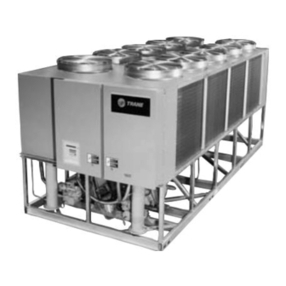
Trane
Trane RTAA-70 Installation & maintenance guide
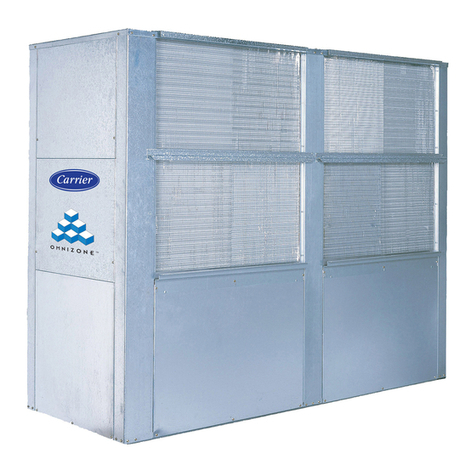
Carrier
Carrier Omnizone 50BVC Installation, Start-Up, Service and Controls Operation and Troubleshooting

York
York YGWH 115 Installation, commissioning & operation
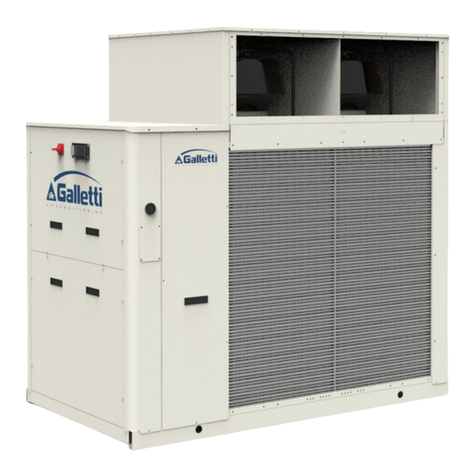
Galletti
Galletti PERFORMA MPE Series Technical manual
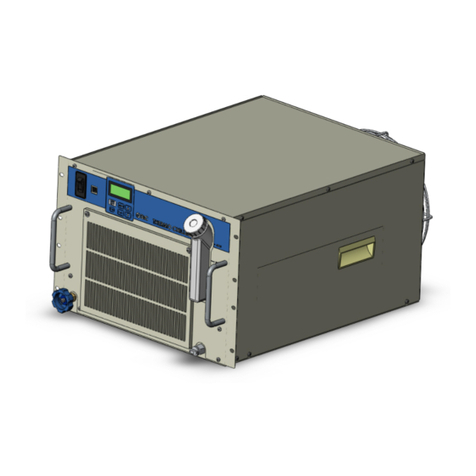
SMC Networks
SMC Networks HRR Series manual

Daikin
Daikin EWAQ016CAW Installation and operation manual

